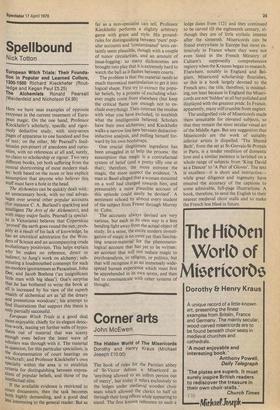Spellbound
Nick Totton
European Witch Trials: Their Foundation in Popular and Learned Culture, 1300-1500 Richard Kieckhefer (Routledge and Kegan Paul £5.25) The Alchemists Ronald Pearsall (Weidenfeld and Nicholson £4.95) Here we have neat examples of opposite extremes in the current treatment of European magic. On the one hand, Professor Kieckhefer's scholarly, specific and rigorously deductive study, with sixty-seven Pages of apparatus to one hundred and five of text ; on the other, Mr Pearsall's feuilletonist pot-pourri of anecdotes and curiosities, with no references at all and, surely, no claim to scholarship or rigour. Two very different books, yet both suffering from the central shortcoming of most modern studies: both based on the more or less explicit assumption that anyone who believes this stuff must have a hole in the head.
The Alchemists can be quickly dealt with : an unnecessary book, with no real advantages over several other popular accounts (for instance C. A. Burland's sparkling and intelligent The Arts of the Alchemists), and With many major faults. Pearsall (a specialist in Victoriana) believes that Copernicus 'proved' the earth goes round the sun; probably as a result of his lack of knowledge, he has an uncritical admiration for the Wonders of Science and an accompanying crude evolutionary positivism. This helps explain Why he makes no reference, direct or indirect, to Jung's work on alchemy; substituting a loudmouthed contempt for such un-modern ignoramuses as Paracelsus, John Dee, and Jacob Boehme Can insignificant little man with big ideas'), One's surprise that .he has bothered to write the book at all is increased by his view of the superb Wealth of alchemical art as 'all the dreary and pretentious woodcuts' ; his attempt to find illustrations that support this thesis is onlY partially successful.
European Witch Trials is a good deal Tore enjoyable, chiefly for its elegant detecnve-work, teasing yet further webs of hypothesis out of material that was scanty enough even before the latest wave of !cholars was through with it. The material in question, for this particular specialism, is the documentation of court hearings on Witchcraft. and Professor Kieckhefer's own sPecialty within the area is to establish criteria for distinguishing between expres!Ions of popular beliefs, and those of the intellectual elite.
If the available evidence is restricted to court documents, then the task becomes both highly demanding, and a good deal less interesting to the general reader. But as far as a non-specialist can tell, Professor Kieckhefer performs a slightly arbitrary game with grace and style. His groundrules for distinguishing between 'pure' popular accounts and 'contaminated' texts certainly seem plausible, though with a couple of minor circularities, and an amount of issue-fogging: so many dichotomies are brought into play that it is extremely hard to watch the ball as it flashes between courts.
The problem is that the material needs so much theoretical manipulation to get it into logical shape. First try to extract the popular beliefs, by a process of excluding whatever might come from elsewhere (but keep the critical flame low enough not to exclude everything). Then contrast the residue with what you have excluded, to establish what the intelligentsia. believed. Scholars have their own alchemies ; and Kieckhefer walks a narrow line here between deductiveinductive analysis, and pulling himself forWard by his own bootstraps.
One crucial illegitimate ingredient has been smuggled in to help the process : the assumption that magic is a contrafactual system of belief (and a pretty silly one at that); therefore, the more extreme the magic, the more suspect the evidence. 'A man at Basel alleged that a woman mounted on a wolf had charged towards him, and presumably a more plausible account of this episode could easily be devised'. A sentiment echoed by almost every student of the subject from Fraser through Murray to Cohn.
The accounts always devised are very various, but each in its own way is a lens bending light away from the actual object of study. In a sense, the entire modern investigation of magic is no more yet than fascinating source-material for the phenomenological account that has yet to be written : an account that will not reduce magic to psychoanalysis, or religion, or politics, but that will recognise it as an immensely widespread human experience which must first be apprehended in its own terms, and then led to communicate with other systems of thought.
ledge dates from 1121 and they continued to be carved till the eighteenth century, although they are of little stylistic interest after the sixteenth. Misericords can be found everywhere in Europe but most extensively in France where they were not even listed in the French Ministry of Culture's supposedly comprehensive registry when the Krauses began to research. Elsewhere, notably in England and Belgium, Misericord scholarship flourishes, so this is a book largely devoted to the French sets; the title, therefore, is misleading, not least because in England the Misericords are not 'hidden' at all but polished and displayed with the greatest pride. In France, apparently, many still crumble from neglect.
The undignified role of Misericords made them unsuitable for elevated subjects, so that they remain the most secular visual art of the Middle Ages. But any suggestion that Misericords are the work of suitably inferior artists is dispelled. 'The Shared Bath', from the set at St-Gervais-St-Protais in Paris, is a tender rendition of domestic love and a similar patience is lavished on a whole range of subjects from 'King David as a Dancer' to 'A Pair of Gloves'. The text is excellent—it is short and instructive— while great diligence and ingenuity have ensured 'the accuracy of the captions to some admirable, full-page illustrations. A book, therefore, to send the English to their nearest medieval choir stalls and to make the French less blasé in future.


































 Previous page
Previous page